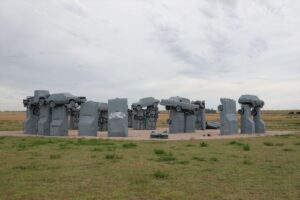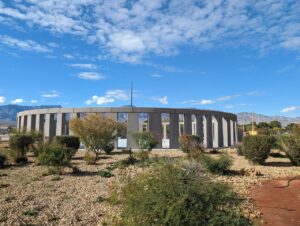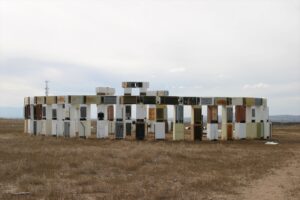A Tale of Two Henges
And a Henge that is no more
Is a henge more than a henge? There are some who believe in sacred geometry and hold that its shape evokes deep mysteries that go beyond our daily lives. It separates the sacred from the ordinary, to enter in is to shift one’s mind. A henge also frames the sky, it invites us to be aware of the seasons and the passage of time. Henges draw us in, whether it be to something ancient or a modern tourist trap.
We have found henges, partial or complete, at shopping centers in Utah and Colorado, a veterans memorial in Washington state, and even a local art work at a nearby house. At one time or the other, these had nearby caches. However, for the purpose of this article, two are of special interest, Carhenge and Ryanhenge.
Carhenge
Carhenge – Sacred Tourist Trap is at one of the most celebrated roadside attractions in the United States. It has been the quest of many road trips, and for us it was a must do stop as soon as we knew we would be within reach of Alliance, Nebraska. It is billed as “Nebraska’s Answer to Stonehenge,” although I am not sure that the original site needed an answer, there is much to be said that in this country the answer to a megalithic monument is an automobile.
The site is impressive. Thirty nine cars were placed to assume the same proportions as Stonehenge, with the circle measuring approximately 96 feet in diameter. A 1962 Cadillac is used for the heel stone. It is not just a tribute — using cars to recreate Stonehenge was a burst of inspiration that must have come from the heavens.
My Log
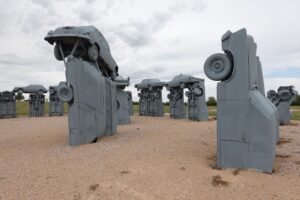 I wondered about whether I would call this sacred, but even more important, why does it feel like it? I have been in the inner circle of Stonehenge twice and in a strange way this evoked a similar feeling. Will future archaeologists come across this site 10,000 years from now and wonder if it served a religious purpose? Perhaps it does.
I wondered about whether I would call this sacred, but even more important, why does it feel like it? I have been in the inner circle of Stonehenge twice and in a strange way this evoked a similar feeling. Will future archaeologists come across this site 10,000 years from now and wonder if it served a religious purpose? Perhaps it does.
I know of some people who turned down seeing Stonehenge because it was just a pile of rocks. I can imagine the same person driving by here because it is just a lot of old cars that should be in a junkyard. But such places are portals, if not to the megalithic world than to imagination and the power of our own creation.
If Carhenge began as a parody, it has grown into something else: a roadside monument that blends humor and reverence. It turns the sacred geometry of a prehistoric site into a commentary on modern America—our worship of the automobile, our love of spectacle, our knack for myth-making with scrap metal.
Like for any such site, we prepared ourselves first. We were lucky that we could stop at Wall Drug and a rest area (a few miles north of here) so we could be in the proper state of mind. I think that helped. Carhenge was transformative. It was not just that it was a henge. It was not even that the henge had hinges. Something else was going on. It was that undefined feeling of visiting a genuine roadside attraction that resonates over time and place. Jonathan Richman should write a song about it, as if he traveled down County Road 59 as a road runner.
Stonehenge whispers across plains that span millennia; Carhenge shouts across a Nebraska cornfield. There is always something to hear there. It is a place where I half expected to see druids in overalls. Or perhaps there would be someone who recognized a car as one they took driving to the county fair or sat in while they stopped during a date. There are the ghosts of past adventures. And now the cars wait, a seemingly hold up the sky.
I was also fortunate to have visited StoneFridge (Fridgehenge) in Santa Fe before it was dismantled by short-sighted officials. I am glad this did not have the same fate, but never take that for granted. Without eternal vigilance. . . .
Ryanhenge
A landfill on the road to Las Vegas, towards Alamo, is an unlikely place for a henge. We stopped on the spur of the moment while driving by after visiting the City, another monumental art work set in the desert. But even though Ryanhenge is on the road to the ET Trail, it took cachers a long while to begin noticing it. The nearest cache is just across the street, but my log was the first to mention that there is more here than a container. No one saw fit to make a virtual here.
As the name indicates Ryan Williams built the henge in 2017. Like the original, it is a solar calendar that centers on the equinox. It has 57 columns built to exacting standards and is made to last — Ryan hopes for at least 5000 years. By then caching will be gone. Will humans even be around to marvel at it, or will aliens similar to those around the henge be taking tourist shuttles to her? Perhaps it will stand in the emptiness waiting for evolution to take its course.
In the center is a flag pole. At noon, it serves as a sundial when light flashes through a hole. At night, standing on Antarctica, it marks the North Star, although I’ll have to take Ryan’s word for that. Inside the henge is a world map, symbols, and various words. The words are not quite as elaborate as the Guidestones used to be, but what does “Carpe Momentum,” “Molina Labe,” and “Versus Et Persever Antia” really mean? I don’t doubt that anything could happen here. As it says in the circle, “It is so ordered.”
My Log
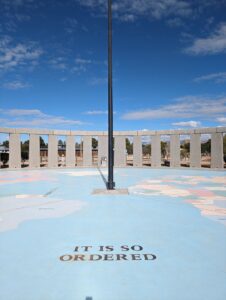 Ryanhenge!! I wouldn’t call this a Stonehenge replica, but it is a henge in its own right.
Ryanhenge!! I wouldn’t call this a Stonehenge replica, but it is a henge in its own right.
Ryan had to watch the sky for over ten years, just to get it right. A circle of concrete stone in the desert sun, a future mystery that has just began, a thousand years or more to last. Merlin was credited with building Stonehenge, but what kind of magic did Ryan have to build this to stand for generations to come and those outside of our future?
We must have been meant to experience it since we only drove past because we changed our route home to avoid a Sierra snowstorm. There happened to be a nearby cache but we had already decided to stop here. We saw a camel as we drove up. There was a concrete Easter Island Māori, Buffalo Bill rail cars, the Christmas express, and a stamp mill. A labyrinth reminds us that silence is golden, life is good, and the law is love. But of course the star was Ryanhenge itself. I would stop anywhere to see a henge structure with an astronomical calendar sundial.
We came up here to visit the City – another earthen monumental work of art meant to last – and find petroglyphs. This was an amazing place to end that portion of our trip. I ended up giving this cache a favorite point just because it happened to be close to the cache. And it should be a must stop for cachers who are going on to the ET Highway, even if it means that there is a little less time for repetitive caching. There are aliens here to help you get in the mood.
I can’t believe no other log mentions it.
 Maybe it does not need to be mentioned, since of course there would be aliens here. As we walked up, Aura Raines, the captain of the Clarian Fleet and a friend of cachers all, was dealing with a Gray who was wandering around the henge. Grays typically do not understand the need for clothing but according to the Rio De Janeiro Interstellar Treaty they should respect local customs along those lines. Aura was left with the task of explaining that before the next tourist arrived. She would much prefer to be helping a geocacher in need.
Maybe it does not need to be mentioned, since of course there would be aliens here. As we walked up, Aura Raines, the captain of the Clarian Fleet and a friend of cachers all, was dealing with a Gray who was wandering around the henge. Grays typically do not understand the need for clothing but according to the Rio De Janeiro Interstellar Treaty they should respect local customs along those lines. Aura was left with the task of explaining that before the next tourist arrived. She would much prefer to be helping a geocacher in need.
It is like a giant puzzle, but the real mystery would be to know what lies on the other side of it. Euclidian geometry only goes so far.
PostScript
These two henges brought to mind FridgeHenge, a circle of old refrigerators at Santa Fe, New Mexico. It never had a cache and was never quite finished. It eventually was storm damaged and the city removed it. But image what would have happened if cachers had taken it on and started a CIRU (Cache In Refrigerators Up) project there with the entire community?
We need a sense of vision and art. Whether the road trip is done with all electric non-Teslas or future hovercraft using an endless power supply, we will always be roadrunners. But to complete what was written above, without eternal vigilance what we have at our sacred tourist attractions may be lost.
